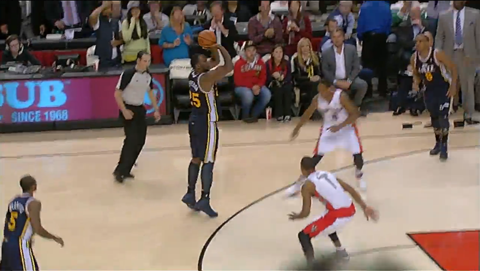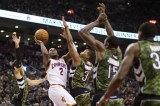
The Raptors continue their road trip by heading into Salt Lake City to face the Jazz tonight.
Normally, this is where there would be some input from a fellow True Hoop Network site to give us some insight on the Jazz, but we weren’t able to work that out this time around. Instead, I’ll do something different just to get you all riled up.
Blind Taste Test – Raptor Bigs

I’ve included a plethora of different statistics here so that, no matter your preference, you can draw a relatively similar conclusion. Obviously the MPG category gives it away here, but if you ignore that, which two bigs would you want to play and why? I think it’s pretty damn obvious, but let’s have a look.
Basic Stats – Player B had the best True Shooting Percentage, the best Rebound Rate, and the best Player Efficiency Rating. Player C is the worst of the four bigs in each of those categories. So when it comes to scoring and rebounding, Player B is the team’s best big so far, while Player C is the worst. Players A and D are very similar and relatively average. In terms of opponent PER, Player C comes out the strongest, while Players A and B are weaker despite being the best shot-blockers.
Complex Stats – Using Offensive Rating, Defensive Rating, and Adjusted Statistical Plus-Minus (which I love in huge samples since it controls for quality of teammates, quality of competition and more, but is still relatively fickle this early in the season), we see a similar picture. Player B has been the team’s best contributor on both ends of the floor. Player D has been of equal value defensively and still a net positive on offense. Player C has been atrocious on both ends, while Player A has been a slight negative at both ends.
Fancy Pants Stats – Using Net Rating (NBA Advanced Stats) when On versus Off the court, we see that Player D has had the biggest positive impact on the team, while Player A has had the worst (I accidentally highlighted the wrong cells here). Players B and C have had relatively little impact on the team’s overall performance. Using ASPM, however, Player B again rockets to the top while Player C is the worst. Using Simple Rating (82Games), again we see Player D being a huge positive, Player A being a negative, and Players B and C being of no impact. Finally, based on Win Shares per 48 Minutes (B-Ref), Players B and D have been the best, Player a is pretty decent, and Player C should be in the D-League.
The Reveal
A: Jonas Valanciunas
B: Ed Davis
C: Andrea Bargnani
D: Amir Johnson
So why is it that the two players with the most consistently positive scores have the fewest minutes? Because of a contract and a perceived need to have Bargnani in the game, of course. You can justify Jonas’ minutes since he is a rookie learning on the fly who needs time to develop, but for the other three the bizarre inverse relationship between performance and minutes is sickening.
The Solution?
To send Jonas to the bench for Amir, of course! At least, so the team thinks. Really, you could have argued switching both starters for both bench players. And while Davis has been the best big in my opinion, there’s certainly a statistical base to justify Amir’s promotion, while anecdotally he also complements Bargnani very well throughout their time together.
Pairings?
Out of curiosity, I pulled NBA Advanced Stats lineup data to see how the different pairs of bigs have performed together. Perhaps Jonas and Ed are playing well as a pair, as are Amir and Andrea, justifying this switch since Dwane Casey tends to roll out subs together?

Alas, that is the case to some degree. In fact, the team has only played well when Bargnani’s on the floor if Amir accompanies him, while Bargs combinations with Davis and Jonas have been net negatives for the team. However, Ed and Jonas have appeared to be horrible complementary pieces. If we could look at ASPM data for lineups, we might see a different picture, since you’ll recall that Amir scored very highly using NBA’s advanced stats, which these are based on. Regardless, we can at least see that the team may be thinking “Hey, Andrea plays better with Amir, maybe we can get him going.”
Whether or not you should have to get a $10M “star” player going with lineup shifts is an entirely different philosophical discussion.
Alas, there is also a game tonight.
Tale of the Tape
Offensive Rating: Utah 104.8 (11th), Toronto 102.8 (19th)
Defensive Rating: Utah 106.4 (21st), Toronto 108.1 (25th)
Pace: Toronto 92.0 (16th), Utah 91.4 (21st)
Strength: Utah O-Reb (4th), Toronto Ball Control (3rd)
Utah D-Reb (27th), Toronto Defensive 3FG% (26th)
Last time around the Raptors went to Triple Overtime with the Jazz only to lose in the end. Hopefully they are kind enough to end it in regulation with a fourth quarter buzzer beater this time around.
No positional breakdown today, my apologies. I’m a little tied up.
Important News
Derrick Favors, Mo Williams and Al Jefferson are all game-time decisions. Obviously there would be huge implications from any of them missing time, though in our reality right now that probably just means it would be Enes Kanter and Earl Watson crushing our spirits instead of Jefferson or Williams.
The Pick
Being “negative” in Raptor-land now means picking narrow losses instead of blowout losses. With that in Mind, I’ll go Jazz by 2 on a game-winning shot by Gordon Hayward, making you all sing CARRY ON MY HAYWARD SON on loop in your heads for the weekend.




